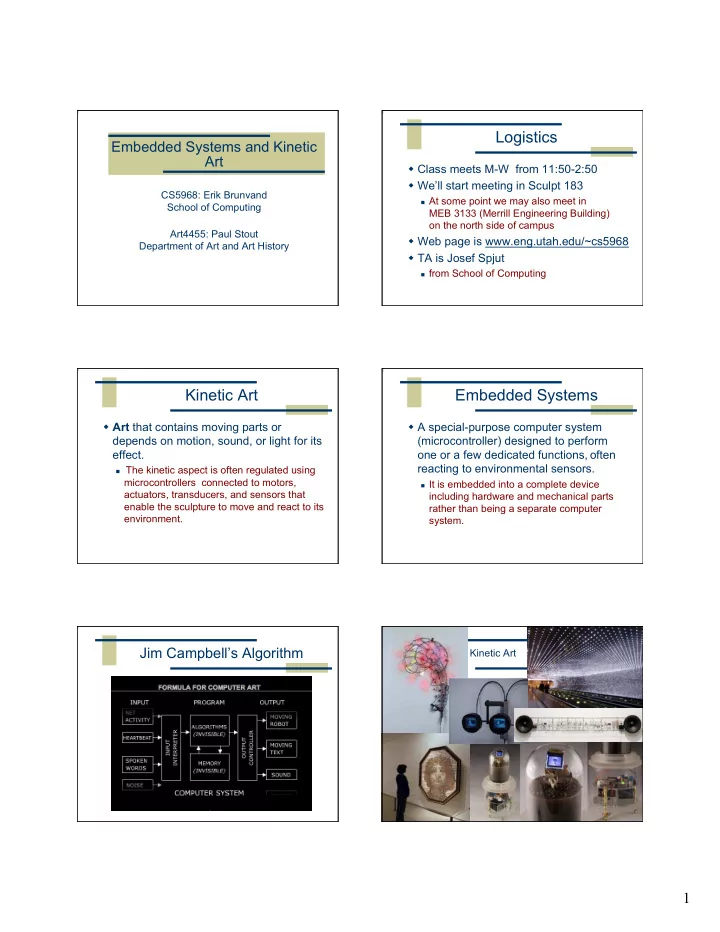

Logistics Embedded Systems and Kinetic Art Class meets M-W from 11:50-2:50 We’ll start meeting in Sculpt 183 CS5968: Erik Brunvand At some point we may also meet in School of Computing MEB 3133 (Merrill Engineering Building) on the north side of campus Art4455: Paul Stout Web page is www.eng.utah.edu/~cs5968 Department of Art and Art History TA is Josef Spjut from School of Computing Kinetic Art Embedded Systems Art that contains moving parts or A special-purpose computer system depends on motion, sound, or light for its (microcontroller) designed to perform effect. one or a few dedicated functions, often reacting to environmental sensors. The kinetic aspect is often regulated using microcontrollers connected to motors, It is embedded into a complete device actuators, transducers, and sensors that including hardware and mechanical parts enable the sculpture to move and react to its rather than being a separate computer environment. system. Jim Campbell’s Algorithm Kinetic Art 1
This Class How will it Work? Good question! It’s an ongoing experiment Enabling engineers and artists to from both sides... collaborate and make some interesting kinetic art Start with some background study Some hand’s-on labs with the microcontroller Artists and engineers to work in interdisciplinary teams Build a toolkit of input sensors, output transducers and computer code to interface with them This will be a cross between an engineering Teams will eventually design a project together class (embedded system design and programming) and an art studio class Class critiques, refinement, final build (designing and building the sculptures) with Exhibit of the results in Spring all students participating fully in both areas. Jim Campbell’s Algorithm Output Transducers Motion Motors - DC, Stepper Servos Light LED, bulbs, etc. Sound Generated, recorded, physical, etc. Input Sensors Electronic Glue Switches Power supplies Resistive sensors Transistors Get analog values based on sensing input used as electronic switches for medium power devices light, temperature, knobs, flex, etc Relays Proximity/motion sensing used as electronic switches for high power PIR, distance, etc. devices resistors, capacitors, wires, etc. 2
Complete Art Piece Kinetic Art Kinetic concept in a well-conceived and constructed artifact Traditional 3d materials Wood, metal, plastic, wiring, and other structural materials Unattended functioning (i.e. in gallery) Consider maintenance and support issues too… Microcontroller The “brains” that coordinates the kinetics Small computers Typically with special support for sensors and actuators Analog-digital converters on inputs pulse-width modulation on outputs We’ll use one called Arduino Arduino Community Open source physical computing platform “open source” hardware open source software environment 328p physical computing means sensing and controlling the physical world Community Examples wiki (the “playground”) Forums with helpful people 3
Arduino Ardweeny Arduino Arduino Test LED on pin 13 Digital I/O pins power LED USB Interface Reset tx/rx LEDs ATmega328 External Power Analog Inputs Arduino ATmega328P Based on the AVR ATmega328p chip 8-bit RISC CPU – 16MHz 8 bit microcontroller (RISC architecture) 32 registers 32k flash for programs 32k Flash, 2k SRAM, 1k EEPROM 3 8-bit I/O ports 2k RAM, 2k EEPROM, 32 registers 6 ADC inputs 14 digital outputs (PWM on 6) 2 8-bit timers 6 analog inputs 1 16-bit timer Built-in boot loader USART SPI/TWI serial interfaces Powered by USB or by external power 4
Programming Arduino Open-source programming environment Arduino language is based on C Actually, it *is* C/C++ Hiding under the hood is gcc-avr But, the Ardiuino environment has lots of nice features to make programming less scary... More Arduino Info? Resources for this class We have some supplies for the class www.arduino.cc/ Arduino boards Main Arduino project web site sensors of various different types www.arduino.cc/playground/Main/HomePage motors and servos “playground” wiki with lots of users and examples LEDs and LED controllers www.freeduino.org/ You should expect to have to buy a few more parts on your own to complete your project “The world famous index of Arduino and Freeduino though... knowledge” We can use the electronics lab in the School of www.eng.utah.edu/~cs5968 Computing, and wood and metal shop facilities in our class web site Art Wedesday Where? We’ll do a hand’s-on session with the Arduino boards Bring a laptop if you have one We’ll write some very simple programs Interface to some very simple sensors/LEDs Meet in Merrill Engineering Building Room MEB 3133 5
Where? Questions? MEB 3133 (DSL) • Third Floor • Main NS hallway on the West side of building • Look for candy machines and metal stairs • East into hallway • Recessed door to 3133 6
Recommend
More recommend